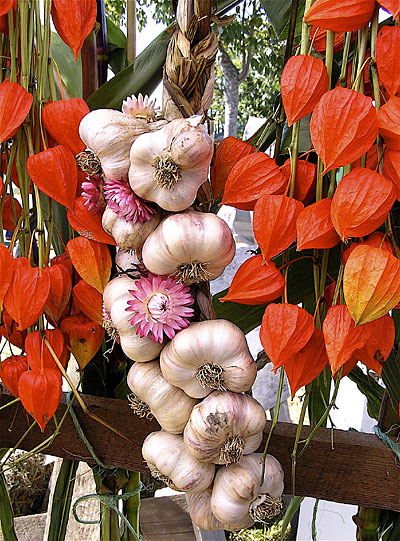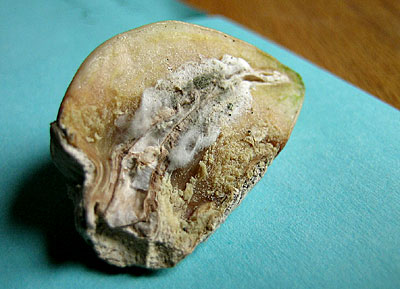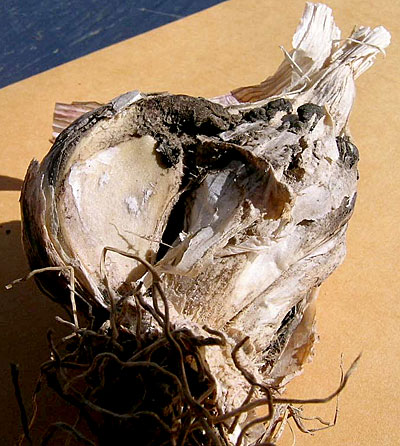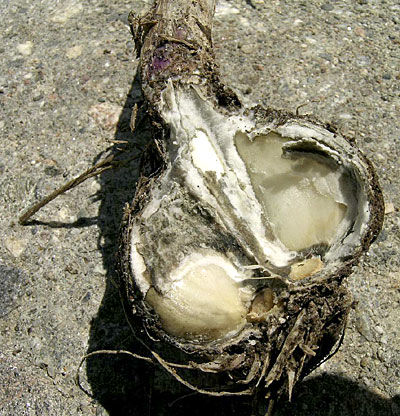 |
| Garlic is increasingly popular among consumers and Maine growers, but three diseases are also increasingly finding the crop appealing. English photo. |
Growing great garlic is easy. Over the past dozen years, I have seen the number of gardeners putting garlic into their repertoire double many times over, and the number of farmers producing seed for sale dramatically increase, too. Almost everyone was getting away with no insect damage and little disease problem, and the word spread. Is the honeymoon period over? Maybe. Certainly it is time to become vigilant.
Gardeners and farmers are now asking experts about garlic that is off-color or covered with growths and mold, as three diseases have become more prevalent in Maine. They are not common yet, but farmers, gardeners and experts need to pay attention to keep them from becoming common, because all three spread with garlic “seed” (cloves), and garlic seed is shared and sold increasingly from local farms.
As with all farming and gardening tribulations, I recommend that you learn as much as you can about the biology and ecology of the organism causing the disease. Three unrelated fungi cause these three burgeoning diseases. We organic growers do not have any sprays that can prevent these diseases, so the information below is more about recognizing the problem and preventing the spread than dealing with a diseased stand.
Penicillium Decay
Penicillium decay may be responsible for poor plant stands in the field but is better known for causing garlic to decay in storage. The common name, blue mold, describes the most obvious symptom: The fungus frequently produces a mass of blue spores on the surface of decaying cloves. Spores are not always produced; sometimes, especially early in its growth and under drier conditions, you will see only white mycelia (a mass of fungal filaments) growing on the surface of cloves. Frequently, pencillium rot affects only a few cloves in a head. I have gotten suspicious heads of garlic to sporulate by placing them in a plastic bag for a few days; when the blue spores form, I know the disease is present. Symptoms in the field include wilted or stunted seedlings due to decay. The fungus can spread into the stem plate of young plants, affect the development of roots and result in weak, yellow leaves.
 |
| Penicillium decay on garlic. Sideman photo. |
Botrytis Rot
The genus Botrytis includes many species. The most common, Botrytis cinerea, causes gray mold and affects numerous plant species, including onions, but does not cause any significant disease in garlic. Botrytis rot of garlic is caused by a different species, Botrytis porri. It is not common but sometimes does incite severe disease and may cause major crop loss.
 |
| Botrytis porri on garlic. Sideman photo. |
White Rot
White rot is the most important and destructive of the fungal diseases of onion and garlic. It is still not common and could even be said to be rare in Maine, but the seriousness of white rot makes it a concern for all garlic growers, farmers and gardeners alike. Once introduced into a field, it can persist as sclerotia for up to 30 years, even without an Allium host.
 |
| White rot. Sideman photo. |
Symptoms on foliage resemble a lot of garlic problems: The older leaves turn yellow and die, the plant is stunted, and later all foliage collapses. Bulbs develop a white, fluffy growth of mycelia around the stem plate and then up the bulb. The fungus eventually grows inward around the storage leaves. Characteristic small, poppy seed-sized sclerotia form, scattered through the fluffy mycelia and in the decaying garlic tissue.
The sclerotia can lay dormant in the soil for many years and not germinate until particular volatile chemicals unique to alliums are present. These organic sulfur materials prompt the sclerotia to germinate from as far as 10 cm away. Germinating sclerotia produce mycelia that can grow through the soil a few centimeters to infect host roots. Secondary infections of the next garlic in a row occur as mycelia grow.
In new fields of garlic, levels of white rot could be very low and go unnoticed for a long time. Many years may pass before sclerotia levels build and spread widely over the field. Also, if conditions are not good for the fungus, i.e., warm and dry, the level of white rot can remain very small, infecting only a few heads in a whole field, even when many sclerotia are present. On the other hand, if the number of sclerotia has built up over the years and conditions are good for fungal growth, large areas of a field can die suddenly.
A grower cannot do much once white rot is in a field. The primary control is to try not to introduce Sclerotium cepivorum into the field. Keep good records of fields with white rot to avoid planting alliums there. When levels are low, destroy infected plants and do not grow alliums in that field. Good sanitation is important to prevent sclerotia from moving between fields on equipment and boots.
Levels of sclerotia in the soil may be reduced by growing bunching onions, which stimulate the sclerotia to germinate if the soil temperature and moisture level is right; the bunching onions are harvested before new sclerotia form. Most important: Inspect your seed and do not plant suspect garlic.
Eric Sideman is MOFGA’s organic crops specialist. Address your questions to him at 568-4142 or [email protected].

